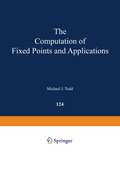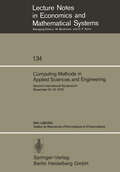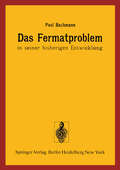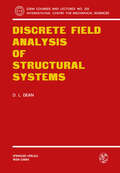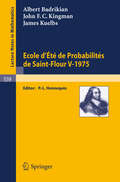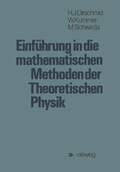- Table View
- List View
The Computation of Fixed Points and Applications (Lecture Notes in Economics and Mathematical Systems #124)
by M. J. ToddFixed-point algorithms have diverse applications in economics, optimization, game theory and the numerical solution of boundary-value problems. Since Scarf's pioneering work [56,57] on obtaining approximate fixed points of continuous mappings, a great deal of research has been done in extending the applicability and improving the efficiency of fixed-point methods. Much of this work is available only in research papers, although Scarf's book [58] gives a remarkably clear exposition of the power of fixed-point methods. However, the algorithms described by Scarf have been super~eded by the more sophisticated restart and homotopy techniques of Merrill [~8,~9] and Eaves and Saigal [1~,16]. To understand the more efficient algorithms one must become familiar with the notions of triangulation and simplicial approxi- tion, whereas Scarf stresses the concept of primitive set. These notes are intended to introduce to a wider audience the most recent fixed-point methods and their applications. Our approach is therefore via triangu- tions. For this reason, Scarf is cited less in this manuscript than his contri- tions would otherwise warrant. We have also confined our treatment of applications to the computation of economic equilibria and the solution of optimization problems. Hansen and Koopmans [28] apply fixed-point methods to the computation of an invariant optimal capital stock in an economic growth model. Applications to game theory are discussed in Scarf [56,58], Shapley [59], and Garcia, Lemke and Luethi [24]. Allgower [1] and Jeppson [31] use fixed-point algorithms to find many solutions to boundary-value problems.
Computing Methods in Applied Sciences and Engineering: Second International Symposium December 15–19, 1975 (Lecture Notes in Economics and Mathematical Systems #134)
by J. L. Lions R. GlowinskiIRIA LABORIA, Institut de Recherche d'Informatique et d'Automatique
Denumerable Markov Chains: with a chapter of Markov Random Fields by David Griffeath (Graduate Texts in Mathematics #40)
by John G. Kemeny J. Laurie Snell Anthony W. KnappWith the first edition out of print, we decided to arrange for republi cation of Denumerrible Markov Ohains with additional bibliographic material. The new edition contains a section Additional Notes that indicates some of the developments in Markov chain theory over the last ten years. As in the first edition and for the same reasons, we have resisted the temptation to follow the theory in directions that deal with uncountable state spaces or continuous time. A section entitled Additional References complements the Additional Notes. J. W. Pitman pointed out an error in Theorem 9-53 of the first edition, which we have corrected. More detail about the correction appears in the Additional Notes. Aside from this change, we have left intact the text of the first eleven chapters. The second edition contains a twelfth chapter, written by David Griffeath, on Markov random fields. We are grateful to Ted Cox for his help in preparing this material. Notes for the chapter appear in the section Additional Notes. J.G.K., J.L.S., A.W.K.
Differential Geometry and Relativity: A Volume in Honour of André Lichnerowicz on His 60th Birthday (Mathematical Physics and Applied Mathematics #3)
by M. Cahen M. FlatoOn the occasion of the sixtieth birthday of Andre Lichnerowicz a number of his friends, many of whom have been his students or coworkers, decided to celebrate this event by preparing a jubilee volume of contributed articles in the two main fields of research marked by Lichnerowicz's work, namely differential geometry and mathematical physics. Limitations of space and time did not enable us to include papers from all Lichnerowicz's friends nor from all his former students. It was equally impossible to reflect in a single book the great variety of subjects tackled by Lichnerowicz. In spite of these limitations, we hope that this book reflects some of the present trends of fields in which he worked, and some of the subjects to which he contributed in his long - and not yet finished - career. This career was very much marked by the influence of his masters, Elie Cartan who introduced him to research in mathematics, mainly in geometry and its relations with mathematical physics, and Georges Darmois who developed his interest for mechanics and physics, especially the theory of relativity and electromagnetism. This par ticular combination, and his personal talent, made of him a natural scientific heir and continuator of the French mathematical physics school in the tradition of Henri Poincare. Some of his works would even be best qualified by a new field name, that of physical ma thematics: branches of pure mathematics entirely motivated by physics.
Differential Topology (Graduate Texts in Mathematics #33)
by Morris W. Hirsch"A very valuable book. In little over 200 pages, it presents a well-organized and surprisingly comprehensive treatment of most of the basic material in differential topology, as far as is accessible without the methods of algebraic topology....There is an abundance of exercises, which supply many beautiful examples and much interesting additional information, and help the reader to become thoroughly familiar with the material of the main text." —MATHEMATICAL REVIEWS
Differential- und Integralrechnung I: Funktionen einer reellen Veränderlichen (Heidelberger Taschenbücher #26)
by Hans Grauert Ingo LiebDIOCLES, On Burning Mirrors: The Arabic Translation of the Lost Greek Original (Sources in the History of Mathematics and Physical Sciences #1)
by G. J. ToomerThis publication would not have been what it is without the help of many institutions and people, which I acknowledge most gratefully. I thank the Central Library and Documentation Center, Iran, and its director, Mr. Iraji Afshar, for permission to publish photo graphs of that part of ms. 392 of the Shrine Library, Meshhed, containing Diocles' treatise. I also thank the authorities of the Shrine Library, and especially Mr. Ahmad GolchTn-Ma'anT, for their cooperation in providing photographs of the manuscript. Mr. GolchTn Ma'anT also sent me, most generously, a copy of his catalogue of the astronomical and mathematical manuscripts of the Shrine Library. I am grateful to the Chester Beatty Library, Dublin, and the Universiteits-Bibliotheek, Leid'en, for providing me with microfilms of manuscripts I wished to consult, and to the Biblioteca Ambrosiana, Milan, for granting me access to its manuscripts. The text pages in Arabic script and the Index of Technical Terms were set by a computer-assisted phototypesetting system, using computer programs developed at the University of Washington and a high-speed image-generation phototypesetting device. A continuous stream of text on punched cards was fed through the Katib formatting program, which broke up the text into lines and pages and arranged the section numbers and apparatus on each page. Output from Katib was fed through the compositor program Hattat to create a magnetic tape for use on the VideoComp phototypesetter.
Discrete Field Analysis of Structural Systems (CISM International Centre for Mechanical Sciences #203)
by Donald L. DeanEcole d'Ete de Probabilites de Saint-Flour V, 1975 (Lecture Notes in Mathematics #539)
by A. Badrikian J. F. Kingman J. KuelbsEconometrics
by Peter Schmidt"A collection of proofs of fundamental theorems, this volume utilizes a format that is exhaustive and consistent. Every result covered in ``Econometrics''is proved as well as stated. One notation system is used throughout the volume. The topics included in the book cover such areas as estimations and testing in linear regression models under various sets of assumptions, and estimation and testing in simultaneous equations models. The latter subject is treated more extensively than in most econometrics books, and the entire volume is characterized by its rigorous level of examination. "
Econometrics: Microeconomics
by Peter Schmidt"A collection of proofs of fundamental theorems, this volume utilizes a format that is exhaustive and consistent. Every result covered in ``Econometrics''is proved as well as stated. One notation system is used throughout the volume. The topics included in the book cover such areas as estimations and testing in linear regression models under various sets of assumptions, and estimation and testing in simultaneous equations models. The latter subject is treated more extensively than in most econometrics books, and the entire volume is characterized by its rigorous level of examination. "
Ein stochastisches Mehrebenenlagersystem mit Sicherheitslager. Stochastische Prozesse mit unabhängigen und stationären Zuwächsen in der Lagerhaltung (Forschungsberichte des Landes Nordrhein-Westfalen #2605)
by Norbert TherstappenEinführung in die Differentialrechnung von Funktionen einer unabhängigen Veränderlichen: Programm für Mathematiker, Naturwissenschaftler und Techniker ab 1. Semester (uni-texte)
by Karl-Heinz ElsterDas vorliegende Lehrprogrammbuch, das aus einem Darbietungs- und einem Übungsprogramm besteht, gibt eine Einführung in die Differential rechnung. Es wendet sich sowohl an solche Leser, die bereits Kenntnisse über diesen Stoff besitzen und ihn festigen und vertiefen wollen, wie auch an solche Leser, die über keine Kenntnisse aus der Differentialrechnung verfügen. In Abhängigkeit von seinen Vorkenntnissen kann jeder Leser selbst bestimmen, welche Teile des Buches er zu studieren hat. Allen denjenigen, die durch wertvolle Hinweise und Anregungen zur Ge staltung des Buches beitrugen, sei an dieser Stelle herzlich gedankt. Unser besonderer Dank gilt den Mitarbeitern des Forschungszentrums für Theorie und Methodologie der Programmierung der Karl-Marx-Universität Leipzig für die großzügige Unterstützung während der Erarbeitung des Lehrprogrammbuches sowie dem Verlag für das verständnisvolle Entgegen kommen bei der Drucklegung. Wir hoffen, daß das vorliegende Lehrpro grammbuch sich unter den Direkt-und Fernstudenten naturwissenschaft licher, ökonomischer, pädagogischer und technischer Studienrichtungen sowie unter den Lehrenden zahlreiche Freunde erwerben wird. Das Programm entstand unter Betreuung von Dr. sc. H. Lohse, Leipzig.
Einführung in die Programmiersprache SIMULA: Anleitung zum Selbststudium (uni-texte)
by Günther LamprechtDiese Einführung in die Programmiersprache SIMULA ist aus einer Lehrveranstaltung entstanden, die im WS 1974/75 und im SS 75 am Rechenzentrum der Universität Bremen abgehalten wurde. Das Buch wendet sich an "Hörer aller Fakultäten" und will ihnen den Zugang zur Datenverarbeitung an Hand einfacher Aufgabenstellungen erleichtern. Die Programmiersprache SIMULA, die am Norwegian Computing Center, Oslos, von 0. J. Dahl, B. Myhrhaug und K. Nygaard entwickelt wurde, ist eine Erweiterung der Programmiersprache ALGOL 60. Die Sprache bietet eine Fülle von Anweisungen, so daß man den Lösungsweg auch bei komplexer Aufgabenstellung übersichtlich be schreiben kann. Das Ziel dieser Einführung in die Programmiersprache SIMULA ist es, den Leser nach und nach mit den Sprachelementen vertraut zu machen. Dabei kommt es weniger darauf auf, die Sprache vollständig zu beschreiben, als vielmehr, beispielhaft zu zeigen, wie man die einzelnen Anweisungen anwenden kann. Alle Programmierbeispiele und Aufgaben wurden auf der Rechenarralge IRIS 80 der Universität Bremen gerechnet und die Ergebnisse im Lösungsteil angegeben und er läutert. Damit hat der Leser die Möglichkeit, seine Programme und Ergebnisse zu kontrollieren. Allen Mitarbeitern des Rechenzentrums bin ich für ihre Anregungen und Verbes serungsvorschläge zu Dank verpflichtet. Frau U. Pochciol möchte ich an dieser Stelle ausdrücklich für ihre Sorgfalt beim Schreiben der Druckvorlage danken.
Einstellung und Verhaltensabsicht: Eine Studie zur schulischen Weiterbildung (Praxis der Sozialpsychologie #6)
by Reinhard OpperElements of the Theory of Representations (Grundlehren der mathematischen Wissenschaften #220)
by A. A. KirillovThe translator of a mathematical work faces a task that is at once fascinating and frustrating. He has the opportunity of reading closely the work of a master mathematician. He has the duty of retaining as far as possible the flavor and spirit of the original, at the same time rendering it into a readable and idiomatic form of the language into which the translation is made. All of this is challenging. At the same time, the translator should never forget that he is not a creator, but only a mirror. His own viewpoints, his own preferences, should never lead him into altering the original, even with the best intentions. Only an occasional translator's note is permitted. The undersigned is grateful for the opportunity of translating Professor Kirillov's fine book on group representations, and hopes that it will bring to the English-reading mathematical public as much instruction and interest as it has brought to the translator. Deviations from the Russian text have been rigorously avoided, except for a number of corrections kindly supplied by Professor Kirillov. Misprints and an occasional solecism have been tacitly taken care of. The trans lation is in all essential respects faithful to the original Russian. The translator records his gratitude to Linda Sax, who typed the entire translation, to Laura Larsson, who prepared the bibliography (considerably modified from the original), and to Betty Underhill, who rendered essential assistance.
Elliptic Functions according to Eisenstein and Kronecker (Classics in Mathematics #88)
by Andre WeilDrawn from the Foreword: (...) On the other hand, since much of the material in this volume seems suitable for inclusion in elementary courses, it may not be superfluous to point out that it is almost entirely self-contained. Even the basic facts about trigonometric functions are treated ab initio in Ch. II, according to Eisenstein's method. It would have been both logical and convenient to treat the gamma -function similarly in Ch. VII; for the sake of brevity, this has not been done, and a knowledge of some elementary properties of T(s) has been assumed. One further prerequisite in Part II is Dirichlet's theorem on Fourier series, together with the method of Poisson summation which is only a special case of that theorem; in the case under consideration (essentially no more than the transformation formula for the theta-function) this presupposes the calculation of some classical integrals. (...) As to the final chapter, it concerns applications to number theory (...).
